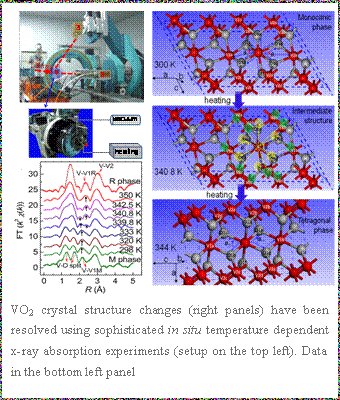Due to its intriguing thermochromic phenomena, originated from the occurrence of a fully reversible metal insulator transition (MIT) that induce large changes in the electrical conductivity and in the near-IR optical properties, the vanadium oxide (VO2) may become a reliable and effective energy-saving material in the future of our daily lives. As one of the prototype materials of correlation effects in condensed matter, the VO2 MIT mechanism has been for long time a hot topic in condensed matter physics since the discovery of VO2 MIT in 1950s. To contribute to the debate about the origin of the VO2 structural phase transition, it is fundamental to monitor in situ both atomic and electronic structural changes during its MIT process triggered by temperature.
Prof. Shiqiang Wei and Prof. Ziyu Wu of the National Synchrotron Radiation Laboratory, and Prof. Yi Xie of the Hefei National Laboratory for Physical Sciences at Microscale (USTC) have obtained an important achievement in the understanding of the MIT mechanism of VO2. The Physical Review Letters magazine of the American Physics Society published their results in the issue of November 26, 2010 (Vol. 105, 226405).

Using temperature-dependent in situ X-ray Absorption Spectroscopy (XAS), this joint team reported for the first time the concurrent atomic and electronic structural evolutions near the VO2 transition temperature at 341 K. The phase transition of VO2 can be now well described by the twisting angle of the nearest V V coordination, and the VO2 metallization occurs in the intermediate monoclinic-like structure with the critical twisting angle of 1.4 . , they claimed. Meanwhile, they also found that the changes of the electronic property and the structural transition in VO2 occur simultaneously. Hence, they proposed a correlative mechanism of structurally driven transition (Peierls) and the electron correlation (Mott) for the MIT of VO2.
Researchers claimed also that these achievements will provide a new theoretical foundation to design new vanadium oxide-based smart-window materials. Furthermore, in order to see in the next future real applications, other studies on doped VO2-based materials exhibiting transitions at room-temperature and nanoscale effects have to be performed.
Related News
Photos
More>>history
- Governor of Uppsala visited ZJU
- Delegation from Faculty of Engineering, Lund University Visited ZJU
- The International Office Holds New Year Reception for International Students
- Chinese-German Exchange Activity was held in Hohai University
- Hohai International Students Joining in Cross-Culture Fun in Nanjing Activity





